Marrying Vega and Zen: The AMD Ryzen 5 2400G Review
by Ian Cutress on February 12, 2018 9:00 AM ESTBenchmarking Performance: CPU Encoding Tests
One of the interesting elements on modern processors is encoding performance. This includes encryption/decryption, as well as video transcoding from one video format to another. In the encrypt/decrypt scenario, this remains pertinent to on-the-fly encryption of sensitive data - a process by which more modern devices are leaning to for software security. Video transcoding as a tool to adjust the quality, file size and resolution of a video file has boomed in recent years, such as providing the optimum video for devices before consumption, or for game streamers who are wanting to upload the output from their video camera in real-time. As we move into live 3D video, this task will only get more strenuous, and it turns out that the performance of certain algorithms is a function of the input/output of the content.
All of our benchmark results can also be found in our benchmark engine, Bench.
7-Zip 9.2: link
One of the freeware compression tools that offers good scaling performance between processors is 7-Zip. It runs under an open-source licence, is fast, and easy to use tool for power users. We run the benchmark mode via the command line for four loops and take the output score.
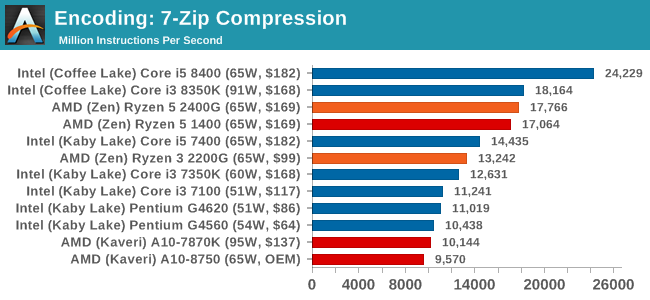
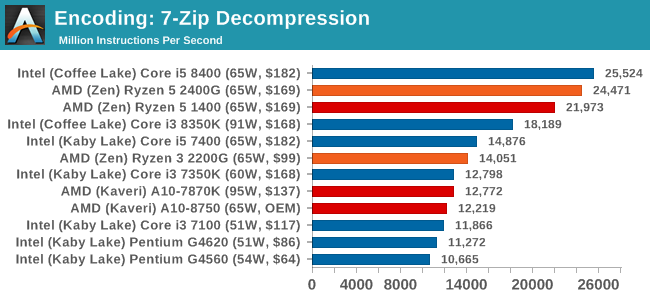
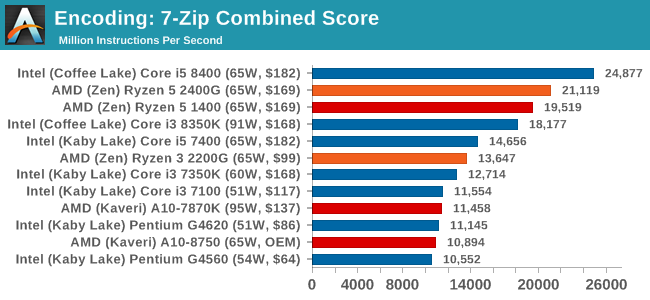
7-zip gives two contrasting stories here. For compression, full cores are needed to get the best performance, with frequency helping as well. However, for decompression, the extra threads help a lot. The combined result looks more like the decompression score, with the Ryzen 5 2400G sitting between the six-core Core i5-8400 and the quad-core Core i3-8350K.
WinRAR 5.40: link
For the 2017 test suite, we move to the latest version of WinRAR in our compression test. WinRAR in some quarters is more user friendly that 7-Zip, hence its inclusion. Rather than use a benchmark mode as we did with 7-Zip, here we take a set of files representative of a generic stack (33 video files in 1.37 GB, 2834 smaller website files in 370 folders in 150 MB) of compressible and incompressible formats. The results shown are the time taken to encode the file. Due to DRAM caching, we run the test 10 times and take the average of the last five runs when the benchmark is in a steady state.
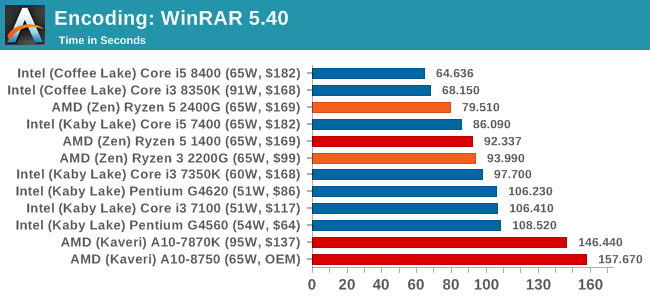
WinRAR is a good scaler with cores, frequency, and memory performance. The eight threads and DDR4-2933 contributes a good amount to the performance here, especially in light of where AMD was. The jump from the Ryzen 5 1400 to the 2400G is also noticable, due to the uptick in frequency and memory speed. The high single-thread performance of the Intel cores still wins out, however.
AES Encoding
Algorithms using AES coding have spread far and wide as a ubiquitous tool for encryption. Again, this is another CPU limited test, and modern CPUs have special AES pathways to accelerate their performance. We often see scaling in both frequency and cores with this benchmark. We use the latest version of TrueCrypt and run its benchmark mode over 1GB of in-DRAM data. Results shown are the GB/s average of encryption and decryption.
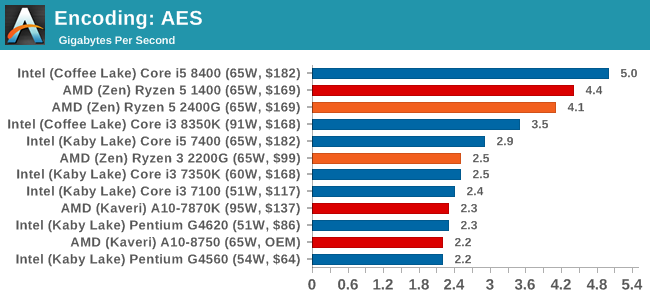
HandBrake v1.0.2 H264 and HEVC: link
As mentioned above, video transcoding (both encode and decode) is a hot topic in performance metrics as more and more content is being created. First consideration is the standard in which the video is encoded, which can be lossless or lossy, trade performance for file-size, trade quality for file-size, or all of the above can increase encoding rates to help accelerate decoding rates. Alongside Google's favorite codec, VP9, there are two others that are taking hold: H264, the older codec, is practically everywhere and is designed to be optimized for 1080p video, and HEVC (or H265) that is aimed to provide the same quality as H264 but at a lower file-size (or better quality for the same size). HEVC is important as 4K is streamed over the air, meaning less bits need to be transferred for the same quality content.
Handbrake is a favored tool for transcoding, and so our test regime takes care of three areas.
Low Quality/Resolution H264: Here we transcode a 640x266 H264 rip of a 2 hour film, and change the encoding from Main profile to High profile, using the very-fast preset.
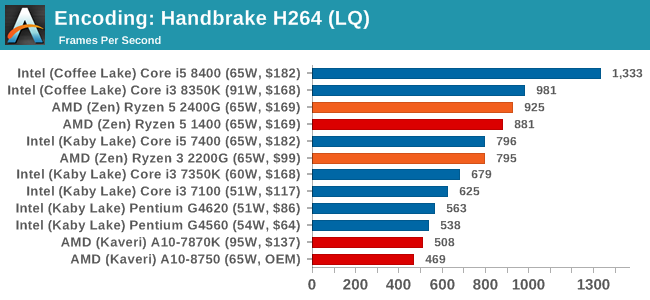
High Quality/Resolution H264: A similar test, but this time we take a ten-minute double 4K (3840x4320) file running at 60 Hz and transcode from Main to High, using the very-fast preset.
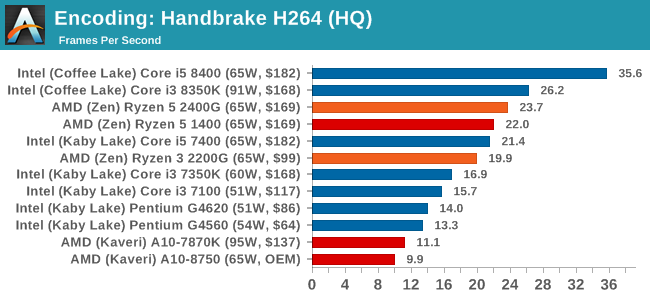
HEVC Test: Using the same video in HQ, we change the resolution and codec of the original video from 4K60 in H264 into 4K60 HEVC.
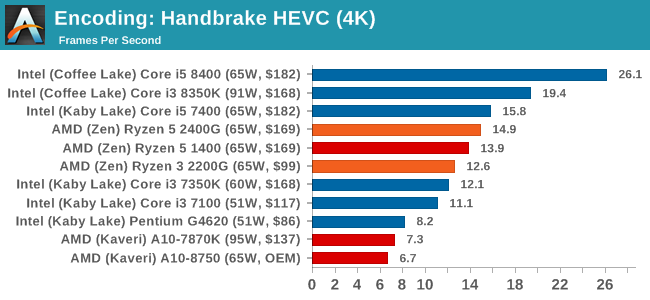










177 Comments
View All Comments
Fritzkier - Tuesday, February 13, 2018 - link
Well not really. While they using Pentium G with GT 730 or lower, many uses AMD A-series APU too (since they no need to use low end discrete GPU to be on par)And Ryzen 2200G also priced the same as Pentium G with GT 730 tho. The exception is RAM prices...
watzupken - Tuesday, February 13, 2018 - link
If AMD uses a beefier Vega IGPU, are you willing to pay for it is the question? I feel iGPU will only make sense if the price is low, or if the power consumption is low. Where Intel is using AMD graphics, is likely for a fruity client. Outside of that, you won't see many manufacturers using it because of the cost. For the same amount of money Intel is asking for the chip only, there are many possible configuration with dedicated graphics that you can think of. Also, the supposedly beefier AMD graphics is about as fast as a GTX 1050 class. You are better off buying a GTX 1050Ti.iwod - Tuesday, February 13, 2018 - link
Well unless we could solve the GPU Crypto problem in the near future ( Which we wont ) I think having better Vega GFx combined with CPU is good deal.Gadgety - Monday, February 12, 2018 - link
Will these APUs do HDR UHD 4k Bluray playback (yes I know it's a tiny niche), or is that still Intel only?GreenReaper - Wednesday, February 14, 2018 - link
Probably best to just get an Xbox One S for it. As a bonus you could play a few games on it, too!watzupken - Tuesday, February 13, 2018 - link
I feel the R3 2200G is still a better deal than the R5 2400G. The price gap is too big relative to the difference in performance. And because these chips are over clocking friendly, so despite the R3 being a cut down chip, there could be some performance catchup with some overclocking. Overall, I feel both are great chips especially for some light/ casual gaming. If gaming is the main stay, then there is no substitute for a dedicated graphic solution.serendip - Tuesday, February 13, 2018 - link
The 2200G is a sweet because it offers most of the 2400G's performance at a sub-$100 point. For most business and home desktops, it's more than enough for both CPU and GPU performance. And with discrete GPUs being so hard to get now, good-enough APU graphics will do for the majority of home users. Hopefully AMD can translate all this into actual shipping machines.I'm going to sound like a broken record but AMD could send another boot up Intel's behind by making an Atom competitor. A dual-core Zen with SMT and cut-down Vega graphics would still be enough to blow Atom out of the water.
msroadkill612 - Tuesday, February 13, 2018 - link
Its a pity they dont get hbcc.msroadkill612 - Tuesday, February 13, 2018 - link
Simply put, amd now own the entry level up to most 1080p gaming, and its a daunting jump in cost to improve by much.Its polite and nice of this review to pretend intel has competitive products, and include them for old times sake.
serendip - Tuesday, February 13, 2018 - link
Looks like AMD owns the good-enough category. As I said previously, let's hope this translates into actual machines being shipped, seeing as OEMs previously made some terrible AMD-based systems at the low end.